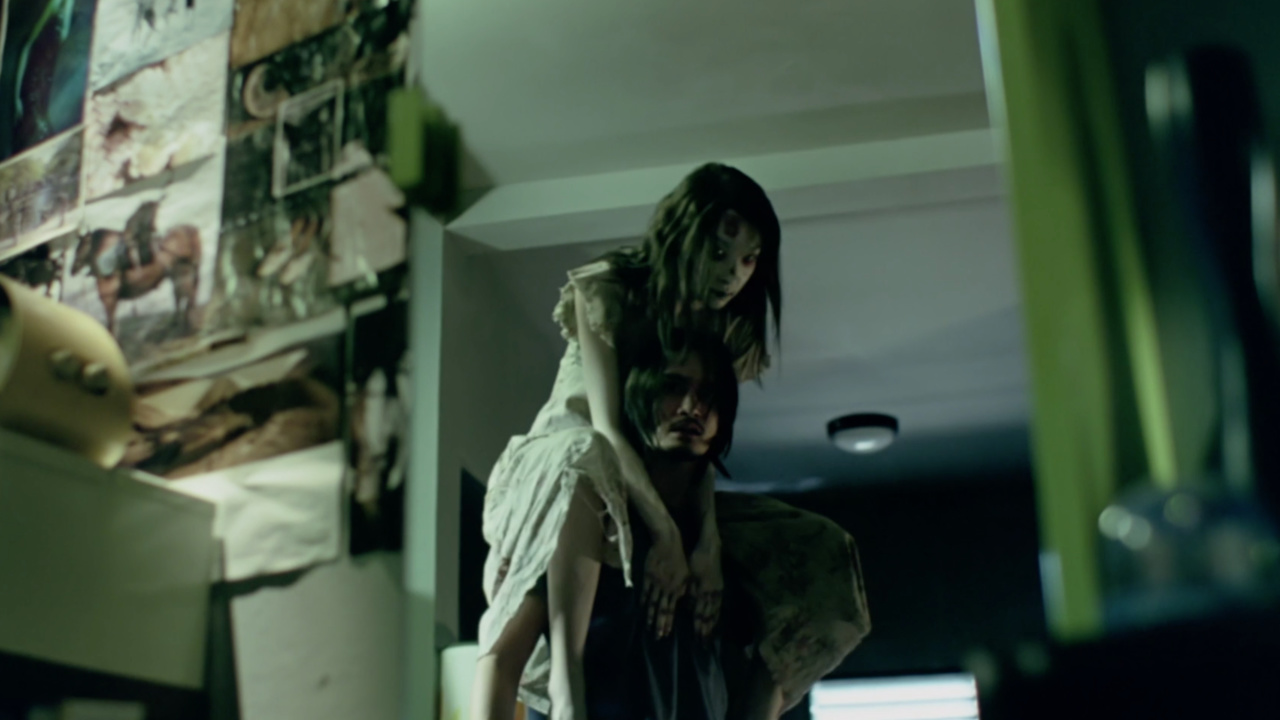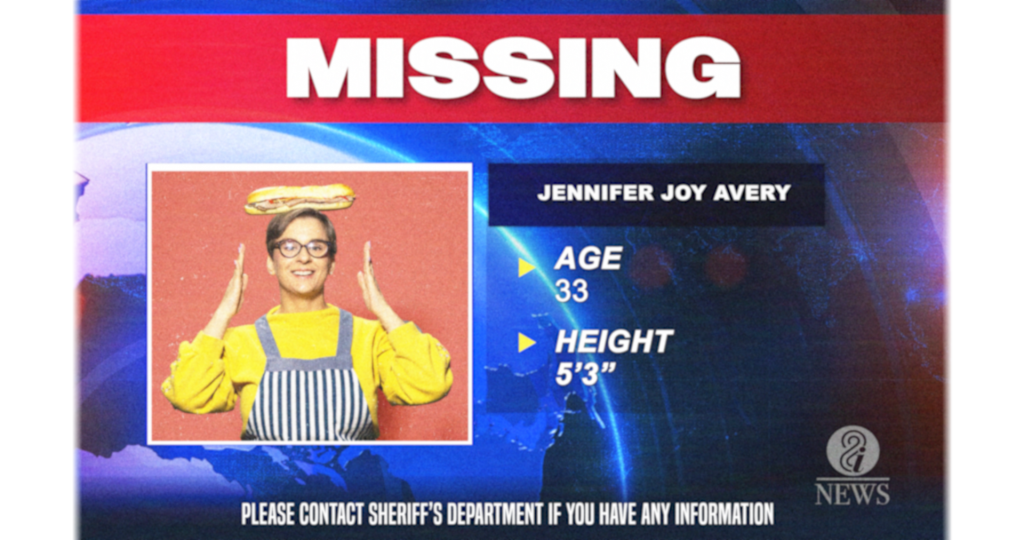Reviews
[REVIEW] ‘Bad CGI Gator’ (2023) Is What You Think It Is, And That’s Fine by Me
Somewhere in South Georgia, a lakeside cabin retreat goes awry: when a dopey group of college students/influencers/all-around awful people drop their laptops into a lake as part of a social media stunt, they create a new terrible semi-aquatic evil: a giant, bad CGI alligator.

It’s been an incredible year for me writing here for HORROR PRESS. I’ve seen beautiful films about loss, and horrifying films about the destruction of the truth. Talked to directors and writers about their deepest passion projects and where they came from. Explored movies about loneliness, grief, hate, and love. And now, I get to talk about a 50-minute-long short film focused on a terribly rendered CGI alligator, called Bad CGI Gator.
A Short Runtime With A Simple Plot
Somewhere in South Georgia, a lakeside cabin retreat goes awry: when a dopey group of college students/influencers/all-around awful people drop their laptops into a lake as part of a social media stunt, they create a new terrible semi-aquatic evil: a giant, bad CGI alligator.
And no, to my lovely editor, James-Michael, I didn’t forget to type the rest of the plot summary. That’s it, that’s the plot. It is 50 minutes to be fair, and moreover, it’s Unity Asset: The Movie, so how long could it really be? I just appreciate it didn’t try to overstay its welcome with a bloated runtime.
In terms of production, it isn’t too far of a cry from what we’ve gotten as of late from Charles Band’s House of Imagineers. They rented out a cabin with a few dollars and a dream, got together some actors, and banged out shooting really quickly to minimize costs. The script might be the film’s weakest aspect, with a lot of misplaced slang that went out of fashion two years ago, being forced out by actors who have been told to play the worst caricature of obnoxious internet influencers hocking skinny tea and vitamin gummies, which they at least are able to do.

A Terribly Good Gator Highlights This Movie
The titular CGI alligator floats above everything like it’s about to bust through the fabric of reality, and that goofy low-effort look works for humor when he starts breaking the laws of physics while eating people. The music is almost certainly all stock, sounding like the copyright-free jams of Kevin Macleod without all the technical skill that goes into those. And the only time the budget is on the loose is whenever you get some passable effects in the alligator attacks, which I can’t lie, are pretty fun regardless of everything else packaging it.
So, if it’s technically poor quality, why do I like this?
This is the part where I tell you I absolutely buried the lead on what this article is really about, which is my own biases. I try to divorce them from a lot of the articles I write, but Bad CGI Gator is one of those I just can’t leave alone even if it was unfunny in every possible way. I appreciate the creation of Bad CGI Gator, not because there is a lot of bright franchise potential here, but because it reminds me a lot of the things I enjoyed when I was younger. See, SyFy has been on a kick of airing big studio films rather than channel original movies for a while now, so I get a bit of a fuzzy feeling whenever I see something that looks and sounds like an Asylum Studios film that would have been on TV in the early 2010s. Something like an Atlantic Rim, or a Megapython vs. Gatoroid, or if I’m really lucky, an Arachnoquake.
A Callback to the Syfy of Yesteryear
Films like this don’t charm me because it’s self-aware, or really meta, or even successfully trying to make synthetic “so bad it’s good” material; that is to say, trying to home-grow an incompetently made movie’s charm gets you zero points from me. It’s charming because I grew up with a lot of really, really, REALLY bad SyFy originals; if you miss that feeling of turning on the channel to a mockbuster or a shark film when home sick from school, or tuning in with nothing to do on a Friday night, you’re my kind of person, and Bad CGI Gator is our type of greasy, familiar comfort food.
I doubt director Danny Draven actually thought intentionally making your film bad guarded against genuine criticism, but I’m also not prone to railing relentlessly on a movie for being bad. So, what can I say is legitimately good out of the comforting warmth of this dumpster fire? When it comes to the acting, we get a nice bit of energy from Ben Vandermey playing the prime fratboy Chad (because of course his name is Chad). He looks like the only person having serious fun here; he hammed up his acting to the Nth degree, and I hope he had a blast filming.
I also have to give a shout-out to Matthew Mark Hunter and James Bell Props for doing up some decent fake blood and fake body parts for the gator to tear off. And also, Tom Gavin, because all gaffers deserve more love.
Everybody else, you did okay too, go hit the showers. Get ready to make Bad CGI Gator vs Bad CGI Crocodile, cause we both know you wrote it down on a whiteboard while thinking up sequels.
Should You Watch Bad CGI Gator?
If you go into this expecting anything really good, I have to point you to the parable of the scorpion and the frog: you knew it was a Full Moon movie called Bad CGI Gator when you started carrying it across the river. It’s still only 50 minutes, so even if you don’t like it, it’s not that much of a slog to get through and still manages to pull some laughs out for how absolutely goofy some of the performances are (and of course, yes, the funny gator model). If you have time to kill or need a bumper for your next bad horror movie marathon, put on Bad CGI Gator.
Reviews
‘Shutter’ (2004) Review: Is Aughts-ful

The aughts were the wild wild west when it came to remakes and reboots. One subgenre that excelled in striking fear into the hearts of North Americans was unquestionably J-horror. It was a craze that gave a 10-ish-year-old me nightmares for too much of my childhood. Out of all of the J-horror remakes that frightened me, the one I never got around to checking out was Shutter. Which is what I was initially going to open this review with. That was until I realized that Shutter wasn’t a J-horror remake! Talk about egg on my face!
A Haunting Tale in Japan
Shutter follows Ben Shaw (Joshua Jackson), a seasoned photographer who moves to Japan with his new wife Jane (Rachael Taylor). Their first night in Japan gets off to an awful start when Jane runs over a mysterious woman at night. Jane starts seeing this mysterious woman throughout her daily life, and Ben’s photos become unusable when a spirit takes them over one by one. Is this spirit coming after Ben and Jane for the accident? Or, is this spirit haunting them for a more sinister reason?
This hastily assembled remake is directed by Masayuki Ochiai and written by Luke Dawson. After Shutter, Dawson’s only other notable script would be the 2015 flop The Lazarus Effect. Which is what I was initially going to write until I learned that The Lazarus Effect brought in nearly $40 million at the box office. It’s difficult to say what the worst part of Shutter is, but the script is definitely at the top of that list. Not only is the script boring and bereft of any real terror, but the characters are beyond flat. Even without having seen Shutter (2004), it was clear what direction this film was taking, and any suspense that could have existed flew right out the window.
Failed Cultural Commentary
Dawson’s script attempts to take a look at white people forcibly inserting themselves into a culture and making it all about themselves. But it’s such a surface-level observation and handled with the care of a five-year-old’s crayon drawing that it’s nearly laughable. At the very least, Shutter does succeed at being a good-for-her film. And for that, I can tip my hat.
Director Masayuki Ochiai and cinematographer Katsumi Yanagijima fail to explore any space in any meaningful way. Japan is a beautiful location, and it’s completely wasted throughout this film. The only really visually interesting moment is the well-choreographed car crash. From there, things quickly go downhill. I’m sure there’s a way to make a film about spirit photography feel interesting and scary, but this is definitely not the right approach.
Shutter is a Forgettable Horror Flop
I’ve covered a lot of films during my tenure at Horror Press that I’ve never seen before. It’s a gamble I’m happy to risk. Whether they hit or miss doesn’t usually matter to me. For some reason, I held Shutter in high regard. I thought people were over the moon for this film. I suppose I can add this to my list of films, such as The Barrens and Warm Bodies, as ones I could easily consider a complete waste of time.
Reviews
Brooklyn Horror Film Festival 2025: ‘Buffet Infinity’ Review

Within the found footage subgenre exists an even more niche and untapped market. Screen life has slowly overtaken found footage; hardcore fans, like myself, ache for something different. One of the more interesting sub-subgenres of found footage is something that I don’t think has a name yet, so let’s name it here and now. How about…TV-gone-rogue! The TV-gone-rogue subgenre is small. Ghostwatch got the ball rolling for these gone rogue-like films, but there was radio silence for quite some time. It would be Chris LaMartina’s WNUF Halloween Special that really brought this idea back into the limelight. Many filmmakers have tried to make TV-gone-rogue interesting, and many have failed. That is until Simon Glassman stepped onto the scene with Buffet Infinity.
Buffet Infinity: A Chaotic Tale of Westridge
The town (city?) of Westridge is whisked into chaos when the new Buffet Infinity restaurant rolls into town. Local sandwich shop owner Jennifer Avery (Allison Bench) is the first to take the soon-to-be conglomerate to task with increasingly pointed advertisements. Suddenly, local restaurant owners/workers go missing in droves as Buffet Infinity expands into neighboring businesses. Sinkholes, missing cityfolk, quarantines, and mysterious sounds abound, leaving residents to ask one question…who really has the sauce?
On the Brooklyn Horror Film Festival schedule, the header image for Buffet Infinity shows multiple people T-posing and floating in the sky. I was immediately sold. I had no clue what I was getting into, and I didn’t want to know. The film was introduced as “one of the craziest we have this year.” (Slightly paraphrasing.) What was I about to watch? Little did I know, it was about to be an hour and forty minutes of small-town madness.
Writers Allison Bench and Elisia Snyder, and writer-director Simon Glassman, transport viewers into an upside down world of weaponized local ads; a thriving town invaded by the deep pockets of monopolized capitalism. As someone who grew up in a decently sized town, though probably not large enough to be considered a city, there was a tinge of nostalgia that accompanied Buffet Infinity. Westridge feels cozy and intimate, a town where everyone knows your name. It’s a “baked in a buttery flaky crust” town. Sure, they have their McDonald’s and Burger Kings, but the real townsfolk eat at Jennifer’s sandwich shop–local knitting circles murmur about what they think is in Jennifer’s secret sauce. Simply put, Westridge feels like a home that many people like myself grew up in. And it reminds us of a simpler time that’s long gone.

A Unique Blend of Humor and Eldritch Terror
Buffet Infinity hides its horror well. It slowly guides the viewer into a sense of unease. As easily as the creators have you laughing, they have you squirming. The absurdist joy quickly transforms into Eldritch terrors from beyond. Many filmmakers say they’re inspired by the idea of it’s-not-what-you-see that’s scary, but many times it feels performative. Bench, Glassman, and Snyder have crafted a truly special script that edges you with terror and excitement. They constantly push you to the edge of release, and then back away. It’s the Japanese water torture of exposition. And, for me, it works incredibly well.
One of the most important aspects of Buffet Infinity is the over-capitalization of our lives. While the creators tackle this idea in a tongue-in-cheek manner, their message is highly effective. For the most part. This constant tete-a-tete between Buffet Infinity and the locals is highly amusing, but brings a larger conversation to the forefront. The town I grew up in is a shadow of what it once was. And I know many feel the same about the towns they grew up in. I can already hear the moans of people who dislike this film: “Brandon, it’s not that deep.” And I would highly disagree. Buffet Infinity feels like a reflective protest film–a loud and proud middle finger at what we should have said when the Super Walmart put mom and pops out of business.
Sorry, this review has gone off the rails. Let’s reel it back in a bit.
Why Buffet Infinity Redefines Found Footage
Buffet Infinity is a riotous romp, a hilarious horror that goes from zero to 100 pretty damn fast. Each commercial slowly builds on its last and uniquely tells its story. This film sets a new precedent for the TV-gone-rogue subgenre. Not to directly compare, but a film like WNUF Halloween Special (a film I love) uses its commercials as a coda; it’s a separation of what you saw/heard and prepares you for the next movement. Buffet Infinity uses its commercial to create the story. Instead of watching news pieces, then irrelevant commercials, then back to news pieces, Buffet Infinity breaks the mold. Hell, it creates the mold.
As someone who has been dying to see a Welcome to Nightvale film, Buffet Infinity is the closest thing I could ask for. It is full of killer performances (looking at you, Ahmed Ahmed), is well-crafted, and sets a new precedent on an underutilized side of found footage. Buffet Infinity is a full-course meal. I highly suspect that Buffet Infinity will gather the unwavering support that Hundreds of Beavers gathered and will go on to be considered an instant classic of the 2020s.























